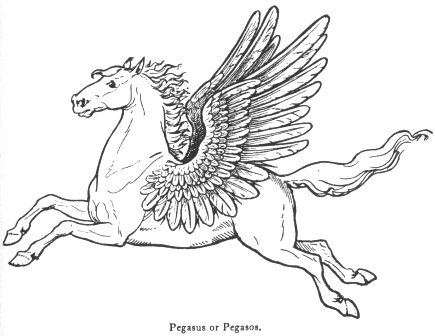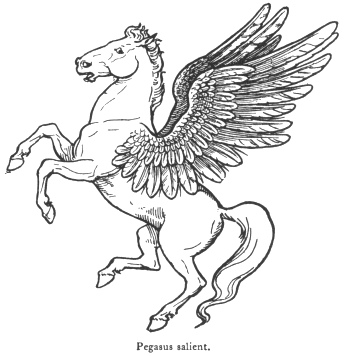
Masonic, Occult and Esoteric Online Library
Fictitious and Symbolic Creatures in Art
By John Vinycomb
Other Chimerical Creatures and Heraldic Beasts-The Pegasus

"The cheval volant—the pegasus—
He bounds from the earth; he treads the air."
A poetic creation of the ancients, a winged horse captured by Bellerophon, the great hero of Corinthian legend. In this he was assisted by the goddess Minerva, who also taught him how to tame and use it. At Corinth there was a temple erected to Αθηναχαλιν?τις (Minerva the Bridler), in allusion to that part of the myth which describes Minerva as instructing Bellerophon in the mode of placing the bridle on the winged steed. The legend states that the hero caught this wonderful animal as it descended at the Acro-Corinthus to drink of the spring of Pirene. Mounted on his winged steed Pegasus,

Bellerophon engaged the dire Chimera, and succeeded in destroying the monster by rising in the air and shooting it with arrows.
Pegasus is the steed of the Muses, and classic story ascribes to it the origin of the Castalian fountain "Hippocrene," situated on Mount Helicon, part of Parnassus, a mountain range in Greece. When the Muses contended with the daughters of Pieros, "Helicon rose heavenward with delight"; but Pegasus gave it a kick, stopped its rise, and there gushed out of the mountain "the soul-inspiring waters of Hippocrene."
The Standard of Corinth was a winged horse, in consequence of the tradition connecting the fountain called Pirene, near the city, with Pegasus, the fiery winged steed of Apollo and the Muses. The same device was the leading type upon the ancient coins of the city of Corinth. The Corinthians founded the colony of Syracuse, in Sicily, which city likewise adopted the winged horse and the head of Athena upon its coinage.
Pindar, who grandly relates the feat of the hero Bellerophon, says that he incurred the enmity of the gods by attempting to fly to heaven on his winged

horse. Zeus sent a gadfly to sting the horse, who thereupon cast its rider and flew of his own accord to the stables of Zeus, whose thunder-chariot he has ever since drawn.
The pegasus is of frequent occurrence in heraldry. In its classic allusions it denotes fame, eloquence, poetic study, contemplation.
Some modern heraldic writers, however, discarding its classic references, regard it merely in the matter-of-fact light as an emblem of swiftness. But it is impossible to disassociate the old and well-known ideas respecting the horse of Apollo and the Muses. In fancy the poet mounts his winged steed to bear his soaring spirit in its wayward flight through the realms of fancy.
As a type of the perfect horseman, Shakespeare pictures Prince Henry as able to
"Turn and wind a fiery pegasus
And witch the world with noble horsemanship."
1 King Henry IV., Act 4, sc. i.
Elsewhere he takes up the later interpretation of the myth, which connects it with Perseus:
"The strong-ribbed bark through liquid mountains cut
Like Perseus’ horse."
Troilus and Cressida, Act i. sc. 3.
Cardinal Bembo, poet and historian, secretary to Pope Leo X., used as his impress a pegasus and a hand issuing from a cloud holding a wreath of laurel and palm, with the motto, "Si te fata vocant" ("If the fates call thee").
Azure, a pegasus salient, the wings expanded argent, is borne as the arms of the Society of the Inner Temple, London.
A very early seal of the Knights Templars exhibits two knights riding upon one horse.
A recent writer remarks upon this strange device that "it is exceedingly probable that some rude and partially defaced representation of this device was mistaken by the lawyers of the reign of Queen Elizabeth for a pegasus. The fact that the Middle Temple adopted the device which appears upon the other seal of the ancient Knights strongly confirms this view."
One of the supporters of the arms of Oliver Cromwell is a horse having the wings and tail of a dragon.
